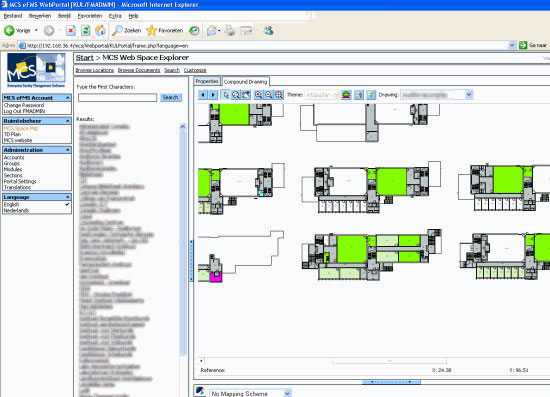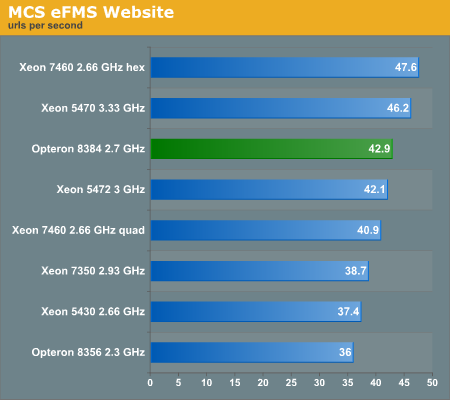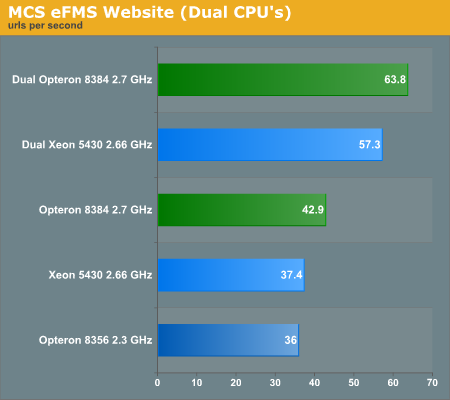The Best Server CPUs Compared, Part 1
by Johan De Gelas on December 22, 2008 10:00 PM EST- Posted in
- IT Computing
MCS eFMS (Windows 2003 32-bit EE)
One of the very interesting and processing intensive applications that we encountered was the modular MCS Enterprise Facility Management Software (MCS eFMS), developed by MCS. The objective of eFMS is to integrate the management of space usage (buildings), assets and equipment (such as furniture, beamers etc.), cabling infrastructure, and other areas while keeping track of costs. MCS eFMS stores all information in a central Oracle database.

MCS eFMS integrates space management, room reservations and much more.
What makes the application interesting to us as IT researchers is the integration of three key technologies: A web-based frontend that integrates CAD drawings and gets its information from a rather complex, ERP-like Oracle database; building overview trees of all rooms available and their reservations in a certain building; and drilling down using the CAD drawing to get more detail: MCS eFMS is one of the most demanding web applications we have encountered so far. MCS eFMS uses the following software:
- Microsoft IIS 6.0 (Windows 2003 Server Standard Edition R2)
- PHP 4.4.0
- FastCGI
- Oracle 9.2
MCS eFMS is used daily by large international companies such as Siemens, Ernst & Young, and Startpeople, which makes testing this application even more attractive. We used the specially developed APUS (Application Unique Stress-testing) software, developed by our own lab to analyze the logs we got from MCS and turn these logs into a real stress test. The result is a benchmark that closely models the way users access the web servers around the world. First we test with only one CPU.

This is the real thing. No team of compiler writers have been losing their sleep to rearrange a few pieces of assembler so that the out of order scheduling can happen as smoothly as possible. Like all business logic code, it is a huge pile of complex layers, one upon the other. It is almost impossible to add some extremely clever "benchmark only boosts" in this one.
Intel takes the top spots, but it needs a 120W 3.3GHz CPU to overpower the newest AMD CPU. Typically there about 6 to 10 frontend servers (the eFMS website) for one backend (the Oracle server), so while the backend server is all about the highest CPU and I/O performance, the frontend is best served with "midrange power" CPUs.

The Opteron improves its performance by 49% and the Xeon by 53% if you add a second quad-core. This benchmark has an error margin of about 3%, so it seems that both CPUs scale more or less the same.










29 Comments
View All Comments
Bruce Herndon - Tuesday, December 23, 2008 - link
I'm surprised by your comments. You claim that VMmark is a CPU/memory-centric benchmark. If I look at the raw data in the VMmark disclosure for Dell's R905 score of 20.35 @ 14 tiles, I see that the benchmark is driving 250-300 MB/s of disk IO across several HBAs and storage LUNs. This characteristic scales with the various systems mentioned in the article.As a designer of VMmark, I happen to know that both storage bandwidth (for the fileserver) and latency (for mail and database)are critical to acheiving good VMmark scores. Furthermore, the webserver drives substantial network IO. The only purely CPU-centric component to VMmark is the javaserver. Overall, the benchmark does exercise the entire virtualization solution - hypervisor, CPU, memory, disk, and network.
cdillon - Tuesday, December 23, 2008 - link
While SAS and Infiniband share some connectors and obtain similar data rates, they are incompatible technologies with two different purposes. Infiniband can be used for disk shelf connections, but it is less common and definitely not the case here. You should not call the connection between the Adaptec 5805 controller and the disk shelf an "Infiniband connection", even if it is using Infiniband connectors and cables, it is simply an SAS connection.JohanAnandtech - Tuesday, December 23, 2008 - link
Well, the physical layer is Infiniband, the used protocol is SCSI. I can understand calling it an "infiniband connection" maybe confusing, but the cable is an infiniband cable.shank15217 - Friday, December 26, 2008 - link
Anand, I think the above poster is right. The Adaptec RAID 5805 uses SFF-8087 connectors but the protocol is SSP (Serial SCSI Protocol). Infiniband is a physical layer protocol that shares the same connector as SAS but they are not the same. Nothing in the Adaptec RAID 5805 spec mentions Infiniband as a supported protocol.http://www.adaptec.com/en-US/products/Controllers/...">http://www.adaptec.com/en-US/products/C...ers/Hard...
niva - Tuesday, December 23, 2008 - link
I'm not sure you can run your same ol benchmark for rendering, and I'd really like more insight into what you guys are rendering and if it's indeed using all 16/24(six core 4 point system)/32(hyperthreading) cores on the system.What renderer, what scene, details details...
These chips get gobbled up by render farms and this is indeed where they can really flex their muscles to the fullest.
JohanAnandtech - Tuesday, December 23, 2008 - link
Just click on the link under "we have performed so many times before" :-)akinneyww - Tuesday, December 23, 2008 - link
I read DailyTech and anandtech.com to keep up with the latest in IT. I appreciate the thought that has gone into putting together this article. I would like to see more articles like this one.Jammrock - Tuesday, December 23, 2008 - link
The VMware results shocked me the most. I know AMD has been working hard on the virtualization sector and it looks like their work has paid off.classy - Tuesday, December 23, 2008 - link
With the rapid increase of virtualization, AMD is looking really strong. We have begun using 3.5 Vmware and are expanding the use of it. Virtualization is truly becoming a big thing in server choice.